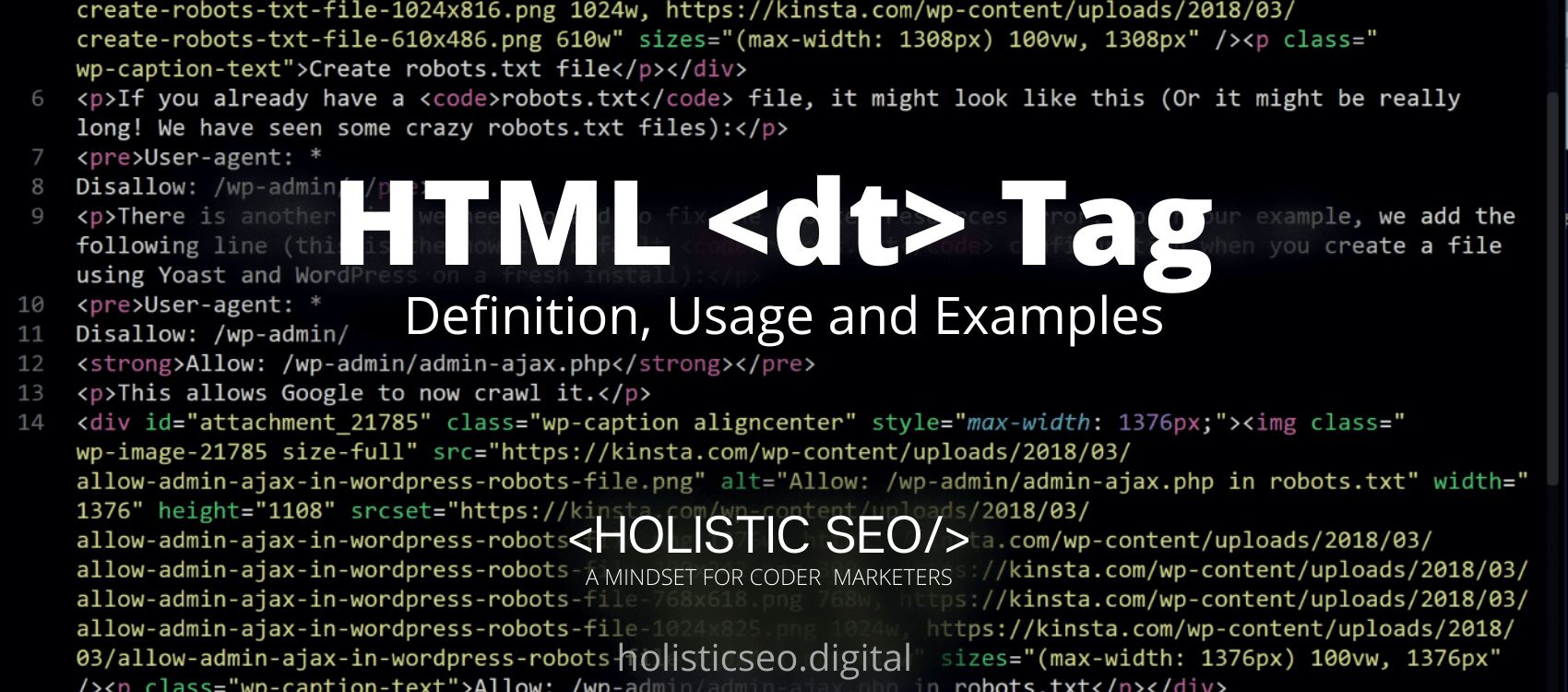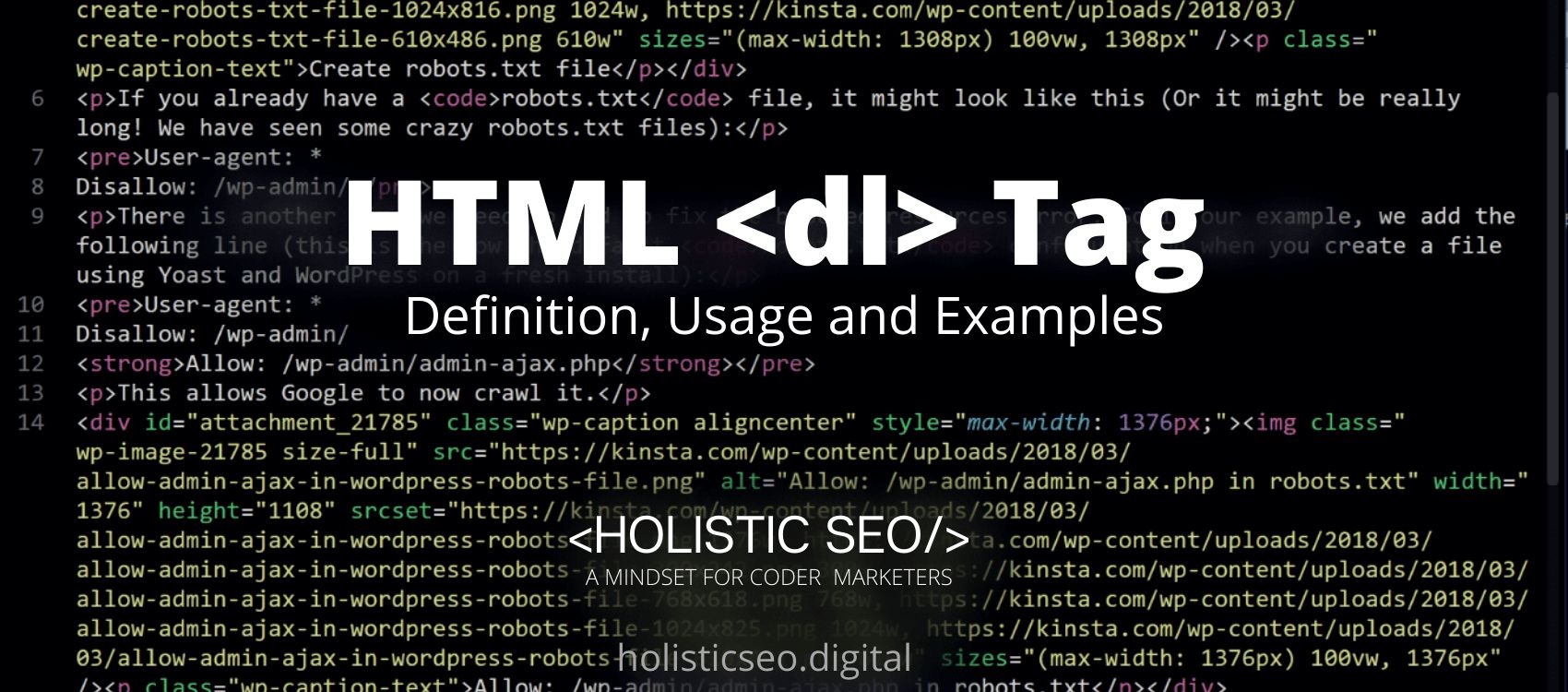The <dt> HTML element is used to specify a term within a description or definition list, and as such must be enclosed within a <dl> HTML Tag. Normally, it is followed by a <dd> HTML Tag; however, multiple <dt> HTML Tag in a row denote several terms that are all defined by the immediately following <dd> HTML Tag. The developer should specify a list of descriptions when using the <dt> HTML Tag. It is enclosed within the <dl> HTML Tag. The <dt> HTML Tag is part of the list tags category in HTML Element Reference. The attributes of the <dt> HTML tag are global attributes and event attributes.
<dt> code block example to learn how it works is given below.
<dl>
<dt>TERM</dt>
<dd>DESCRIPTION</dd>
<dt>TERM</dt>
<dd>DESCRIPTION</dd>
</dl>The second example usage of the “<dt>” code block example is below.
<dl>
<dt>Color</dt>
<dd>Red</dd>
<dt>Size</dt>
<dd>Medium</dd>
</dl>What is <dt> HTML Tag?
The <dt> HTML tag is used to define a description list. It is necessary for web developers because it is contained within the <dl> HTML Tag. Typically, it is followed by a <dd> HTML Tag. The following <dd> HTML tag provides some context for the term specified in <dt> HTML Tag.
How to Use <dt> HTML Tag?
To use the <dt> HTML Tag, the developer should use the format <dt></dt>, inserting the definition term between the start and end tags then this tag will specify the list of descriptions. It is contained within the <dl> HTML Tag.
Example Usage of <dt> HTML Tag?
The following example of usage of <dt> HTML Tag is given below.
<p>The following are the assigned persons to clean each area of the house. </p>
<dl>
<dt>Mark</dt>
<dd>Dining Area</dd>
<dt>Daniel</dt>
<dd>Kitchen Area</dd>
</dl>What are the Attributes of <dt> HTML Tag?
There are multiple attributes for the <dt> HTML Tag. The following attributes are listed below.
- Global Attributes: The <dt> HTML tag supports Global Attributes. All HTML elements, even those not specified in the standard, can have global attributes. This means that any non-standard elements must nevertheless allow certain characteristics, even if using such elements makes the content non-HTML5 compliant.
- Event Attributes: The <dt> HTML tag supports Event Attributes. The Event Attributes always have a name that begins with “on” and is followed by the name of the event for which it is intended. They specify a script to run when an event of the defined type is dispatched to the element with the specified attributes.
What are the Default CSS Settings for <dt> HTML Tag?
The following is the Default CSS Setting for the <dt> HTML Tag.
p,
dl {
font: 1rem 'Fira Sans', sans-serif;
}
dl > dt {
font-weight: normal;
font-style: oblique;
}
dd {
margin-bottom: 1rem;What are the Related other HTML Tags to <dt>?
The other related HTML Tags to <dt> HTML Tag are listed below.
- <dl> HTML Tag: The <dl> HTML Tag is related to <dt> HTML Tag because they are both list tags. The <dl> HTML Tag specifies a list of descriptions. The terms and their descriptions are listed in the description list.
- <ol> HTML Tag: The <ol> HTML Tag is related to <dt> HTML Tag because they are both list tags. On a website or web page, the <ol> HTML Tag defines an ordered list. The ordered list element’s default list style is numerical or decimal.
- <ul> HTML Tag: The <ul> HTML Tag is related to <dt> HTML Tag because they are both list tags. The <ul> HTML Tag is used to define an unordered list.
- <li> HTML Tag: The <li> HTML Tag is related to <dt> HTML Tag because they are both list tags. The <li> HTML Tag is used to specify list or menu items.
- 48 Online Shopping and Consumer Behavior Statistics, Facts and Trends - August 22, 2023
- B2B Marketing Statistics - August 22, 2023
- 38 Podcast Statistics, Facts, and Trends - August 22, 2023


